![[OpenVMS documentation]](../../images/openvms_doc_banner_top.gif)
|
![[Site home]](../../images/buttons/bn_site_home_off.gif)
![[Send comments]](../../images/buttons/bn_comments_off.gif)
![[Help with this site]](../../images/buttons/bn_site_help_off.gif)
![[How to order documentation]](../../images/buttons/bn_order_docs_off.gif)
![[OpenVMS site]](../../images/buttons/bn_openvms_off.gif)
![[Compaq site]](../../images/buttons/bn_compaq_off.gif)
|
| Updated: 11 December 1998 |
![[OpenVMS documentation]](../../images/openvms_doc_banner_top.gif)
|
![[Site home]](../../images/buttons/bn_site_home_off.gif)
![[Send comments]](../../images/buttons/bn_comments_off.gif)
![[Help with this site]](../../images/buttons/bn_site_help_off.gif)
![[How to order documentation]](../../images/buttons/bn_order_docs_off.gif)
![[OpenVMS site]](../../images/buttons/bn_openvms_off.gif)
![[Compaq site]](../../images/buttons/bn_compaq_off.gif)
|
| Updated: 11 December 1998 |
Guidelines for OpenVMS Cluster Configurations
| Previous | Contents | Index |
In a multipath configuration, the first path to a device that OpenVMS configures is chosen as the initial current path. Note that this overrides the selection of a preferred path through HSx console commands such as the following:
SET UNIT PREFERRED_PATH=this_controller or other_controller |
For this reason, it is not recommended that the OpenVMS system manager set preferred paths at the HSx console. Instead the manual path switching commands, described in Section 6.8.7 should be used.
In case of failover, OpenVMS chooses an alternate path according to the following order of precedence:
OpenVMS avoids unnecessary failover from one HSx controller module to another because:
When an I/O operation to a multipath disk fails and the failure suggests that a retry (on the current path or an alternate path) might succeed, then failover proceeds as follows:
6.4 Configuration Requirements and Restrictions
The requirements for multipath SCSI configurations are presented in
Table 6-1.
| Component | Description |
|---|---|
| Alpha console firmware | For systems with HSZ70 and HSZ80, the minimum revision level is 5.3. For systems with HSG80, the minimum revision level is 5.4 |
| Controller firmware | For HSZ70, the minimum revision level is 7.3; for HSZ80, it is 8.3; for HSG80, it is 8.4. |
| Controller module mode | Must be set to multibus mode. The selection is made at the HS x console. |
| Full connectivity |
All hosts that are connected to an HS
x in multibus mode must have a path to both HS
x controller modules. This is because hosts that are connected
exclusively to different controllers will switch the logical unit back
and forth between controllers, preventing any I/O from executing.
To prevent this from happening, always provide full connectivity from hosts to controller modules. If a host's connection to a controller fails, then take one of the following steps to avoid indefinite path switching:
|
| Allocation classes |
A valid HSZ allocation class is required (refer to Section 6.6.3). If a
SCSI bus is configured with HSZ controllers only, and all the
controllers have a valid HSZ allocation class, then it is not necessary
to adhere to the older SCSI device naming rules for that bus. That is,
the adapters do not require a matching port allocation class, or a
matching node allocation class and matching OpenVMS adapter device
names.
However, if there are non-HSZ devices on the bus, or HSZ controllers without an HSZ allocation class, then the standard rules for node and port allocation class assignments and controller device names for shared SCSI buses must be followed. |
The restrictions for multipath SCSI configurations are presented in Table 6-2.
| Component | Description |
|---|---|
| Devices supported | DKDRIVER disk devices attached to HSZ70, HSZ80, and HSG80 controller modules are supported. Other device types, such as tapes, and class drivers, such as GKDRIVER, are not supported. |
| Mixed version and mixed architecture clusters | All hosts that are connected to an HSZ or HSG in multibus mode must be running OpenVMS Version 7.2 or higher. All Version 6.2 systems must have installed the cluster compatibility kit, as described in the OpenVMS Version 7.2 Release Notes. |
| Host based volume shadowing | In the initial release of OpenVMS Version 7.2, multipath devices can not be members of host-based shadow sets. This restriction will be removed by a Version 7.2 update kit. |
| SCSI to MSCP failover | In the initial release of OpenVMS Version 7.2, the MSCP path can not be included in the multipath set. This is accomplished by setting the SYSGEN parameter MPDEV_REMOTE = 0. This is the default setting in OpenVMS Version 7.2. This restriction will be removed by a Version 7.2 update kit. |
Prior to the introduction of multipath failover support, parallel SCSI configurations using HSZ70 storage controllers already provided transparent failover. Transparent failover is failover from one controller port to the corresponding port on the other controller module. Both ports must be on the same host bus.
Multipath failover offers another level of failover, from one SCSI bus to another.
The figures in this section show systems configured for transparent failover, and for multipath failover. The special considerations for controller modules that have multiple ports, like the HSZ80 are also described.
6.5.1 Transparent Failover
Transparent failover in a parallel SCSI configuration, as shown in
Figure 6-4, requires that both controller modules be on the same SCSI
bus.
Figure 6-4 Parallel SCSI Configuration With Transparent Failover
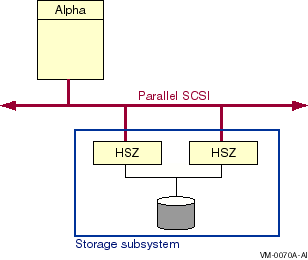
In this configuration:
6.5.2 Multibus Failover and Multiple Paths
A parallel SCSI configuration with multiple paths from the host to
storage offers higher availability and performance than a configuration
using transparent failover. Figure 6-5 shows this configuration.
Figure 6-5 Parallel SCSI Configuration With Multibus Failover and Multiple Paths
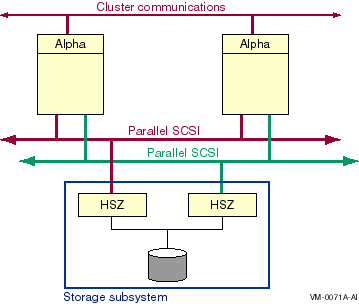
Note the following about this configuration:
6.5.3 Configurations Using Multiported Storage Controllers
Higher levels of availability and performance can be achieved with the
use of multiported storage controllers, such as the HSZ80. The HSZ80
storage controller is similar to the HSZ70 except that each HSZ80
controller has two ports.
This section shows three configurations that use multiported storage controllers. The configurations are presented in order of increasing availability.
Figure 6-6 shows a single host with a single interconnect, using an HSZ80 in transparent mode.
Figure 6-6 Multiported Parallel SCSI Configuration With Single Interconnect in Transparent Mode
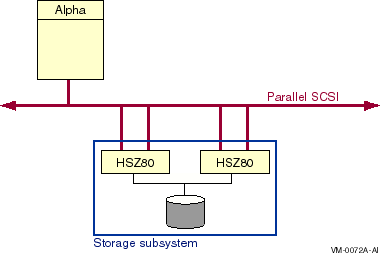
Note the following about this configuration:
Figure 6-7 shows a system configured in transparent mode using two paths from the host.
Figure 6-7 Multiported Parallel SCSI Configuration With Multiple Paths in Transparent Mode
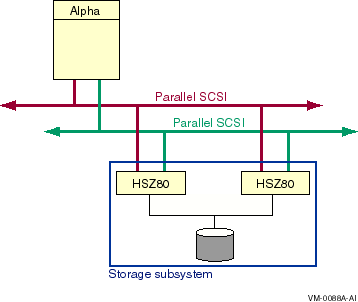
In this configuration:
Note that in this configuration, although there are two buses, there is only one path from the host to a particular logical unit. When a controller fails, the logical unit moves to the corresponding port on the other controller. Both ports are on the same host bus.
This configuration has better performance than the one in Figure 6-6 because both SCSI buses can be simultaneously active. This ocnfiguration does not have higher availability, however, because there is still only one path from the host to the logical unit.
Figure 6-8 shows a system using the multiported HSZ80 storage controller configured in multibus mode.
Figure 6-8 Multiported Parallel SCSI Configuration With Multiple Paths in Multibus Mode
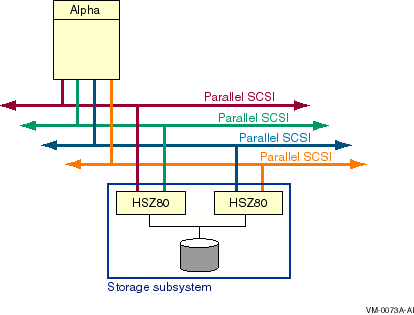
In this configuration:
6.6 Device Naming for Parallel SCSI Multipath Configurations
SCSI device names have evolved as systems have become larger and more
complex. At first, SCSI device names were entirely path dependent. The
device name indicated the node, host adapter, SCSI bus ID, and logical
unit number (LUN) used to access the device. Path-based names are not
suitable for multiple host and multiple path environments because:
The first two of these issues were addressed by the use of the node
allocation class and the port allocation class. The third issue
requires the introduction of an HSZ controller-based allocation class.
These three allocation classes are reviewed in the following sections.
6.6.1 Review of Node Allocation Classes
A node allocation class is used in a device name in place of a node name. A node allocation class is needed to produce a unique device name when multiple nodes have a direct connection to the same SCSI device.
A node allocation class can only be used in a device name when all nodes that share access to a SCSI storage device:
Figure 6-9 shows a configuration whose devices are named using a node allocation class.
Figure 6-9 Devices Named Using a Node Allocation Class
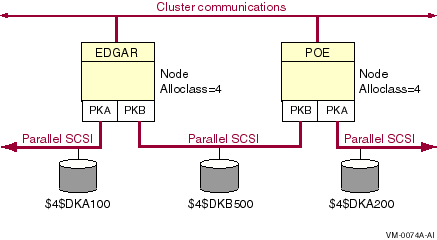
6.6.2 Review of Port Allocation Classes
A port allocation class in a device name designates the host adapter
that is used to access the device. The port allocation class replaces
the node allocation class in the device name, and the adapter
controller letter is set to the constant A.
The port allocation class can be used when SCSI systems need more SCSI IDs to produce unique device names, or when the controller letter of the adapters on a shared bus do not match. A port allocation class can only be used in a device name when all nodes that share access to a SCSI storage device have only one direct path to the device.
Figure 6-10 shows a configuration whose devices are named using a port allocation class.
Figure 6-10 Devices Named Using a Port Allocation Class

6.6.3 Device Naming Using HSZ Allocation Classes
When any node has multiple buses connecting to the same storage device,
the new HSZ allocation class shown in Figure 6-11 must be used.
Figure 6-11 Devices Named Using an HSZ Allocation Class
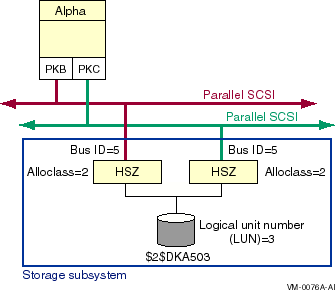
An HSZ allocation class is similar to the HSC, HSD, and HSJ allocation classes. The device name, using an HSZ allocation class number, takes the following form:
$HSZ-allocation-class$ddcu |
where:
The system manager sets an HSZ allocation class from the HSZ console, using the following command:
SET this_controller or other_controller ALLOCATION_CLASS = n |
where n is a value from 1 to 999.
When the allocation class is set on one controller module in a dual redundant configuration, it is automatically set to the same value on the other controller.
In the following example, the allocation class is set to 199. The example shows that the value is set for both controllers.
z70_B => set this allo=199
z70_B => sho this
Controller:
HSZ70 ZG64100136 Firmware XB32-0, Hardware CX25
Configured for MULTIBUS_FAILOVER with ZG64100160
In dual-redundant configuration
Device Port SCSI address 6
Time: NOT SET
Host port:
SCSI target(s) (0, 2, 3, 4, 5, 6)
TRANSFER_RATE_REQUESTED = 20MHZ
Host Functionality Mode = A
Allocation class 199
Command Console LUN is target 0, lun 1
Cache:
32 megabyte write cache, version 4
Cache is GOOD
Battery is GOOD
No unflushed data in cache
CACHE_FLUSH_TIMER = DEFAULT (10 seconds)
NOCACHE_UPS
z70_B => sho other
Controller:
HSZ70 ZG64100160 Firmware XB32-0, Hardware CX25
Configured for MULTIBUS_FAILOVER with ZG64100136
In dual-redundant configuration
Device Port SCSI address 7
Time: NOT SET
Host port:
SCSI target(s) (0, 2, 3, 4, 5, 6)
TRANSFER_RATE_REQUESTED = 20MHZ
Host Functionality Mode = A
Allocation class 199
Command Console LUN is target 0, lun 1
Cache:
32 megabyte write cache, version 4
Cache is GOOD
Battery is GOOD
No unflushed data in cache
CACHE_FLUSH_TIMER = DEFAULT (10 seconds)
NOCACHE_UPS
|
The following rules pertain to the use of an HSZ allocation class in SCSI device names:
6.7 Fibre Channel Multipath Configurations
The Fibre Channel storage controller (HSG80) provides the same
configuration options in transparent mode as the parallel SCSI storage
controller (HSZ80). That is, in transparent mode, failover can occur
from one controller module to another provided they are on the same
bus. Furthermore, dual ports on each storage controller increase the
available failover options.
Figure 6-12 shows a single system with redundant paths to each HSG80 storage controller. The storage controllers are configured in transparent mode. Each HSG80 provides a standby port to which I/O can fail over.
Figure 6-12 Single Host With Two Dual-Ported Storage Controllers on a Single Bus
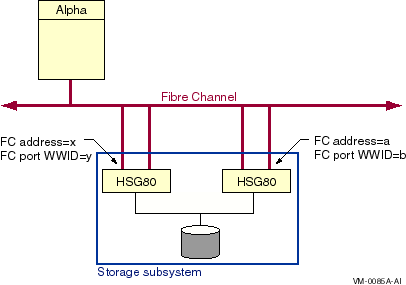
Note the following about this configuration:
In this configuration, if one path fails, the standby port takes over the other port's Fibre Channel address and port worldwide ID (WWID).
Figure 6-13 shows a multipath configuration with the storage controllers configured in multibus mode. This means that each HSG80 port has its own Fibre Channel address and Fibre Channel port WWID.
This configuration is not possible using parallel SCSI as the interconnect because the SCSI address for a port is part of the device name. Because of this difference in naming, an additional configuration option is available with Fibre Channel---multiple ports on the same Fibre Channel.
Figure 6-13 Single Host With Two Dual-Ported Storage Controllers and Two Buses
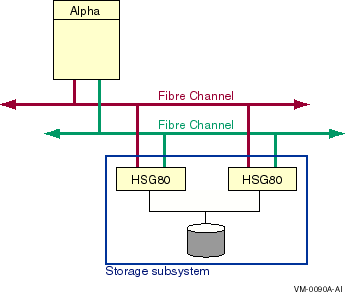
Note the following about this configuration:
Because of the second bus, this configuration provides a higher level of availability than the configuration in Figure 6-12.
Figure 6-14 shows another multipath configuration with its storage controllers configured in multibus mode.
Figure 6-14 Single Host With Two Dual-Ported Storage Controllers and Four Buses
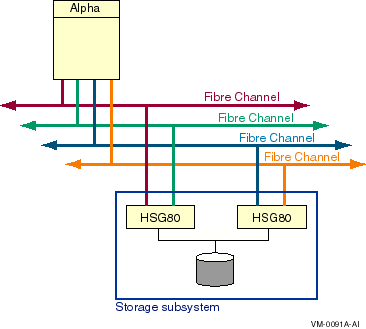
Note the following about this configuration:
6.8 Implementing Multipath Configurations
Parallel SCSI and Fibre Channel interconnects support multipath
configurations. Implementation of these configurations is similar, and
the system parameters and the command for specifying paths are the
same. The syntax for the path identifiers differs.
Implementing multiple paths to devices consists of the following steps:
Figure 6-15 shows a valid multipath, multihost configuration.
Figure 6-15 Two Hosts With Shared Buses and Shared Storage Controllers
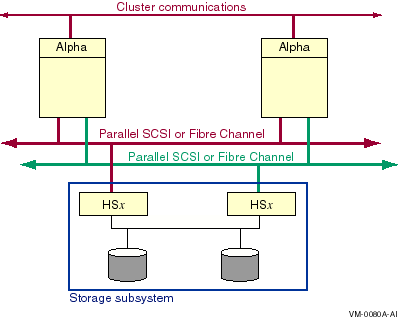
Note the following about this configuration:
This configuration provides each host with two direct paths and one MSCP served path to each device.
Figure 6-16 shows a valid multipath configuration for systems that are not configured on the same bus.
Figure 6-16 Two Hosts With Shared, Multiported Storage Controllers
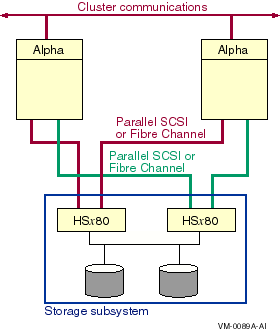
Note the following about this configuration:
This configuration provides each host with two direct paths, one to each storage controller, and one MSCP served path to each device.
| Previous | Next | Contents | Index |
![[Site home]](../../images/buttons/bn_site_home_off.gif)
![[Send comments]](../../images/buttons/bn_comments_off.gif)
![[Help with this site]](../../images/buttons/bn_site_help_off.gif)
![[How to order documentation]](../../images/buttons/bn_order_docs_off.gif)
![[OpenVMS site]](../../images/buttons/bn_openvms_off.gif)
![[Compaq site]](../../images/buttons/bn_compaq_off.gif)
|
![[OpenVMS documentation]](../../images/openvms_doc_banner_bottom.gif) |
|
Copyright © Compaq Computer Corporation 1998. All rights reserved. Legal |
6318PRO_006.HTML
|